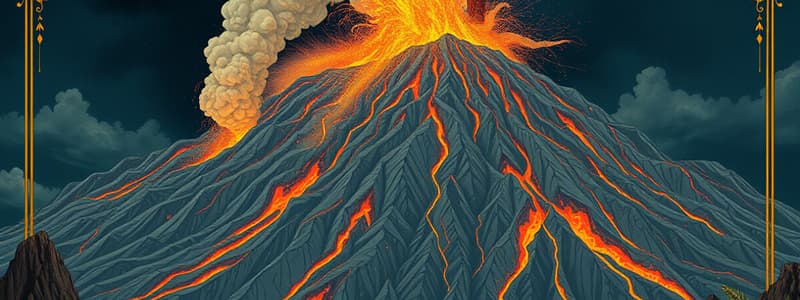Podcast
Questions and Answers
What phrase indicates the urgency of Mr. Johnston's final message?
What phrase indicates the urgency of Mr. Johnston's final message?
- One of the first casualties.
- A crack in the rock.
- Mount St. Helens exploded.
- This is it! (correct)
What was the immediate consequence of the earthquake mentioned?
What was the immediate consequence of the earthquake mentioned?
- Mr. Johnston evacuated the area.
- Mount St. Helens erupted. (correct)
- People became aware of the danger.
- The ground shook continuously.
Which word best describes the nature of the eruption mentioned?
Which word best describes the nature of the eruption mentioned?
- Devastating (correct)
- Unexpected
- Catastrophic
- Minor
Which event mentioned likely contributed to Mr. Johnston being a casualty?
Which event mentioned likely contributed to Mr. Johnston being a casualty?
What does the word 'urged' imply about the public's response?
What does the word 'urged' imply about the public's response?
What was the primary cause of the powerful explosion at Mount St. Helens?
What was the primary cause of the powerful explosion at Mount St. Helens?
How many people lost their lives as a result of the Mount St. Helens eruption?
How many people lost their lives as a result of the Mount St. Helens eruption?
What area was primarily affected by the initial blast of the eruption?
What area was primarily affected by the initial blast of the eruption?
What seismic event occurred shortly before the eruption on March 20th?
What seismic event occurred shortly before the eruption on March 20th?
How high did the ash cloud rise into the atmosphere during the explosion?
How high did the ash cloud rise into the atmosphere during the explosion?
Flashcards are hidden until you start studying
Study Notes
Volcano Eruption Summary
- Mount St. Helens' eruption on May 18, 1980, was the most destructive in American history.
- The explosive event was preceded by a build-up of pressure, leading to a powerful explosion.
- The eruption resulted in a fast-moving cloud of superheated gas, impacting the surrounding areas severely.
- Fifty-seven lives lost and tens of thousands affected by the eruption's devastation in Washington State.
- An initial blast affected approximately 230 square miles, with immediate fatalities within 8 miles of the volcano.
Seismic Activity
- Earthquakes were recorded, including a significant 4.2 magnitude quake on March 20, 1980, marking the start of continuous tremors.
- Continuous seismic activity indicated an escalation leading to the volcanic eruption.
- A second major explosion occurred, sending ash 10 miles into the atmosphere, continuing to spread over time.
Ash and Damage
- By April 22, ash production halted, but estimates suggested hundreds of tons of ash might be generated in total.
- The north side of the volcano bulged out significantly, indicating magma movement toward the surface.
- Damage assessments will likely remain incomplete until after volcanic activity ceases.
Final Moments and Casualties
- Volcanologist David Johnston, stationed near the volcano, reported no new changes shortly before the eruption.
- A magnitude-5.1 earthquake struck before the final explosion, which was catastrophic, taking Johnston's life.
- The eruption was characterized by its powerful impact on both the landscape and local population, leaving a significant mark on geological and human history.
Volcano Erupción: Mount St. Helens
- Mount St. Helens erupted violently on May 19, 1980, marking the most destructive volcanic activity in U.S. history.
- The initial eruption left 57 people dead and tens of thousands impacted in Washington State.
- The explosion was caused by a build-up of pressure within the volcano, leading to a powerful outburst.
- A glowing cloud of superheated gas shot out from the mountain at supersonic speed.
- Everything within an 8-mile radius of the blast was killed immediately, while materials within 19 miles were flattened by the shockwave.
- A total area of approximately 230 square miles was devastated by the eruption's initial impact.
Seismic Activities
- Earthquakes and tremors were recorded leading up to the eruption, including a 4.2 magnitude earthquake logged on March 20.
- Continuous tremors began after the initial eruption, with another notable explosion sending ash 10 miles into the atmosphere.
- An observation made two days before the eruption revealed the north side of the volcano bulged nearly 140 meters, indicating rising magma.
- Volcanologists monitored seismic activities to assess potential changes and the extent of damage post-eruption.
Ash Fallout and Public Safety
- Following the eruption, the public was urged to avoid ash fall where possible due to health and safety concerns.
- It was estimated that hundreds of tons of ash could be produced as additional eruptions continued over subsequent weeks.
- Scientists anticipated difficulties in determining the full extent of damage until after the aftermath of the eruption had settled.
Casualties and Warning Systems
- David Johnston, a volcanologist monitoring the volcano, tragically became one of the eruption's early casualties.
- The eruption's unpredictability highlighted the importance of warning systems and real-time monitoring of volcanic activity.
Studying That Suits You
Use AI to generate personalized quizzes and flashcards to suit your learning preferences.




